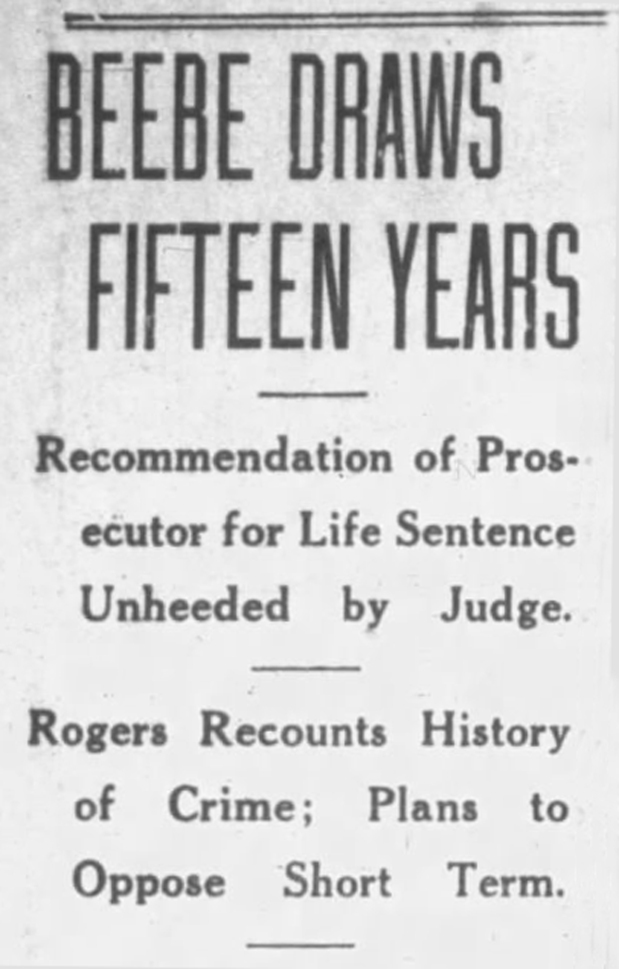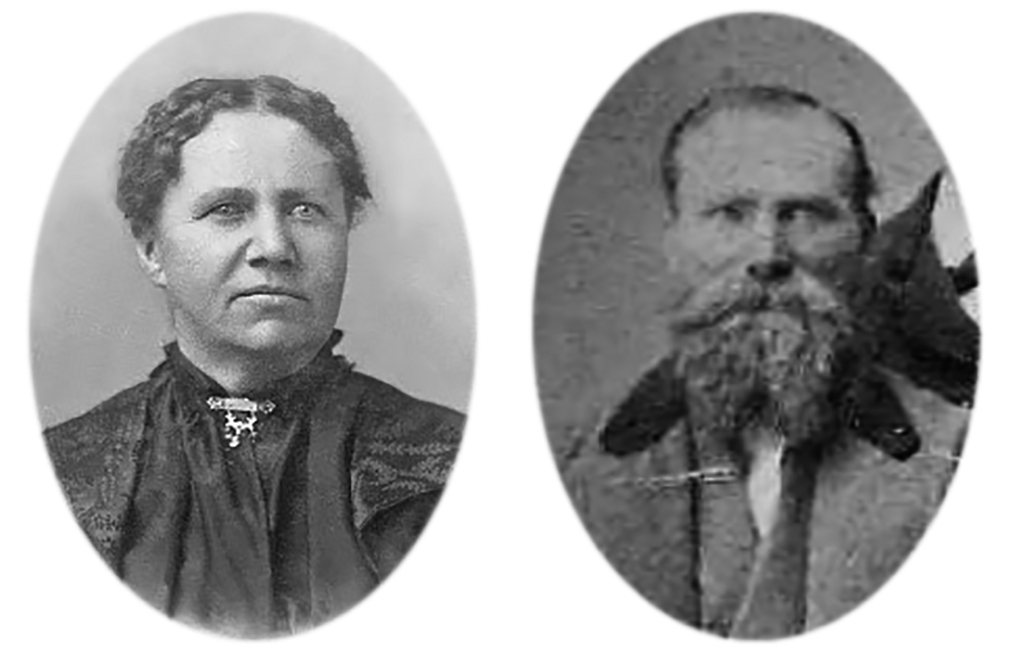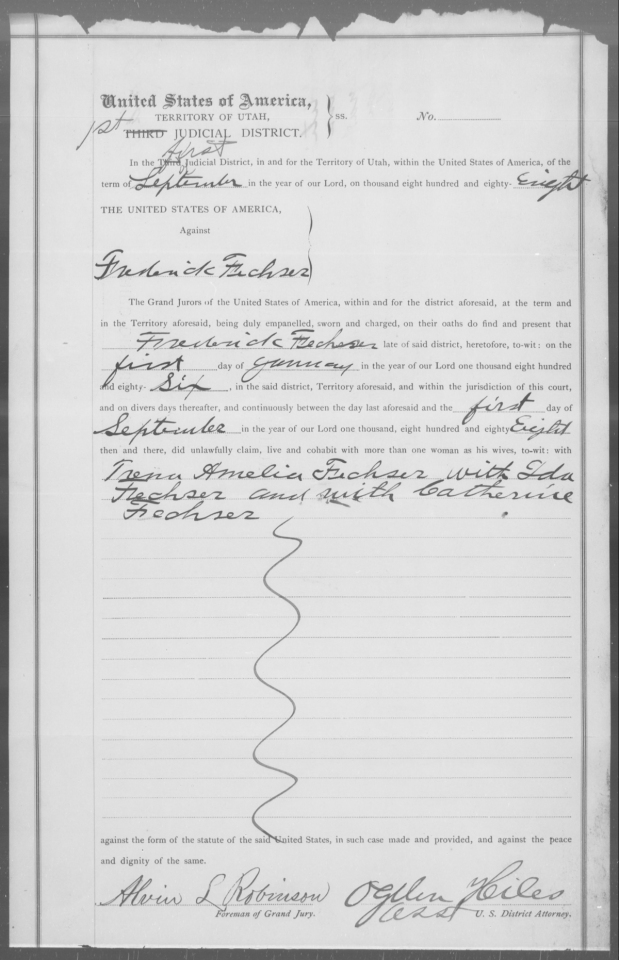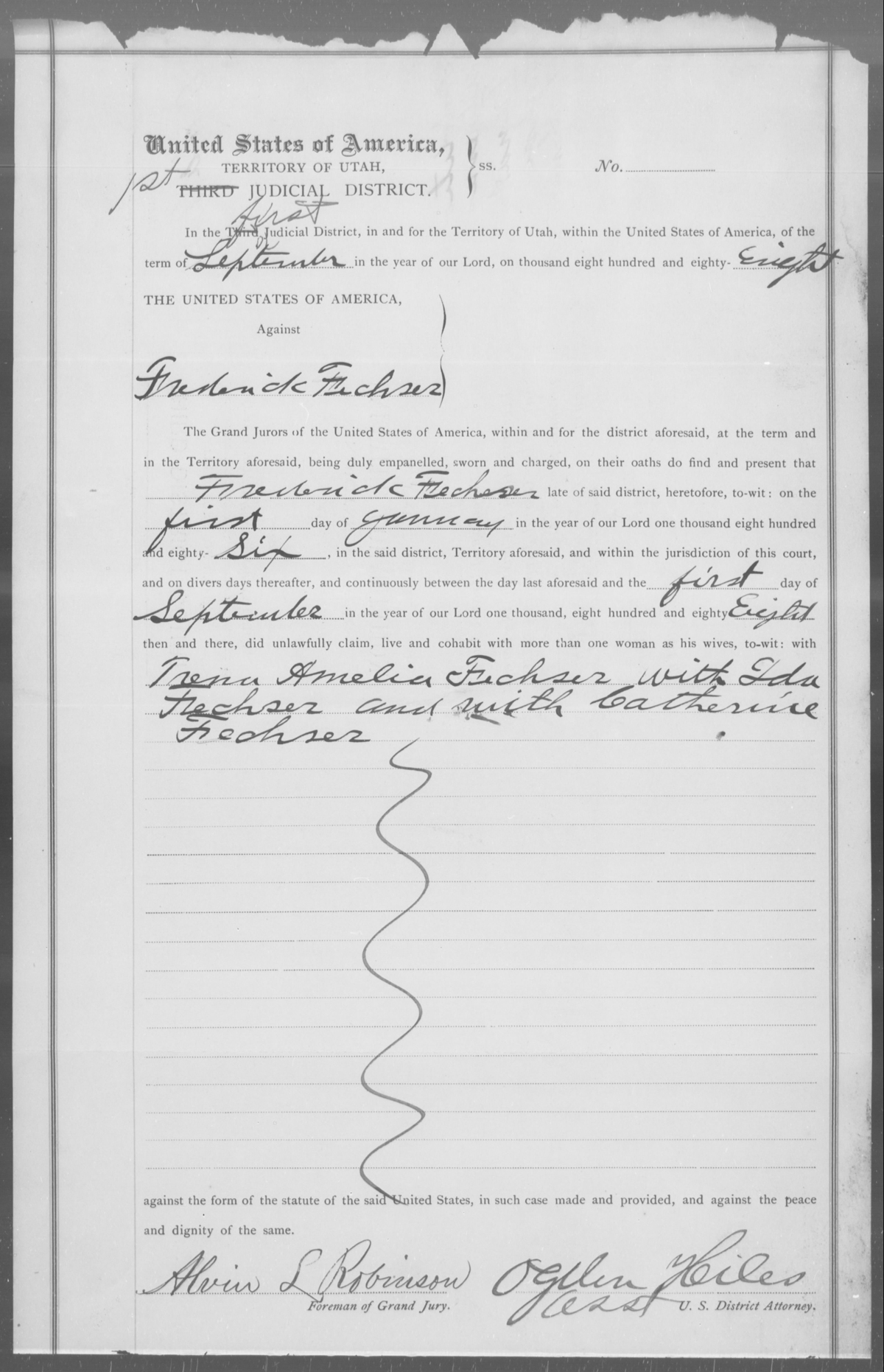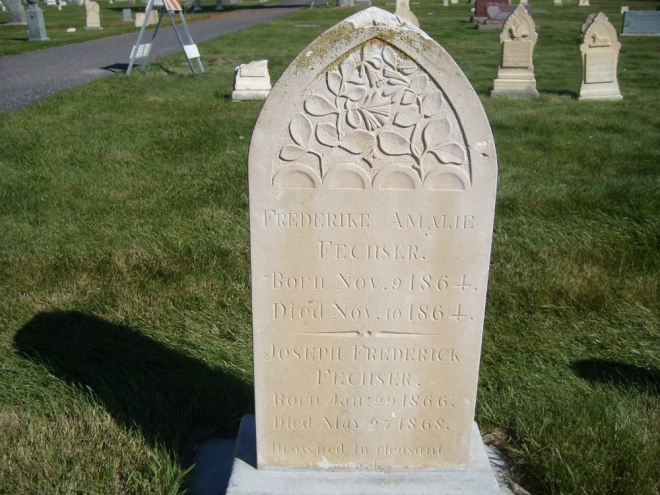The story of someone’s history may often be titled “The Life and Times of …,” but I am titling the story of Gilber Clyde Beebe “The Wives and Crimes of …” since Gilbert was married to multiple wives and was sent to prison for multiple crimes.
Gilbert Clyde Beebe is a very distant relative, since I believe he was married only briefly to my first cousin two generations removed, Florence Iona Carlston. However, I have a fondness for investigative reporting, so when I discovered another criminal in my family history, no matter how distant, I felt compelled to research it. Hence, my research into the wives and crimes of Gilbert Clyde Beebe.
Determining Who Was Who in the Story
Florence Iona Carlston, was the granddaughter of my second great grandparents, Johann Friedrich Fechser and Ida Christina Johnson. Florence, the third of nine children born to Josephine Fechser and her husband, Franklin Ernal Carlston, was born on December 31, 1897, in Mount Pleasant, Sanpete County, Utah. She was married to Raymond A. Larson on April 24, 1924, in Salt Lake City. They were divorced shortly after the birth of their third child. At the time of the 1940 census, she was living with her parents in Salt Lake City, and their children were living with their father in McCammock, Bannock County, Idaho. At the time of her death on September 20, 1945, she was married to Frank A. Jones.
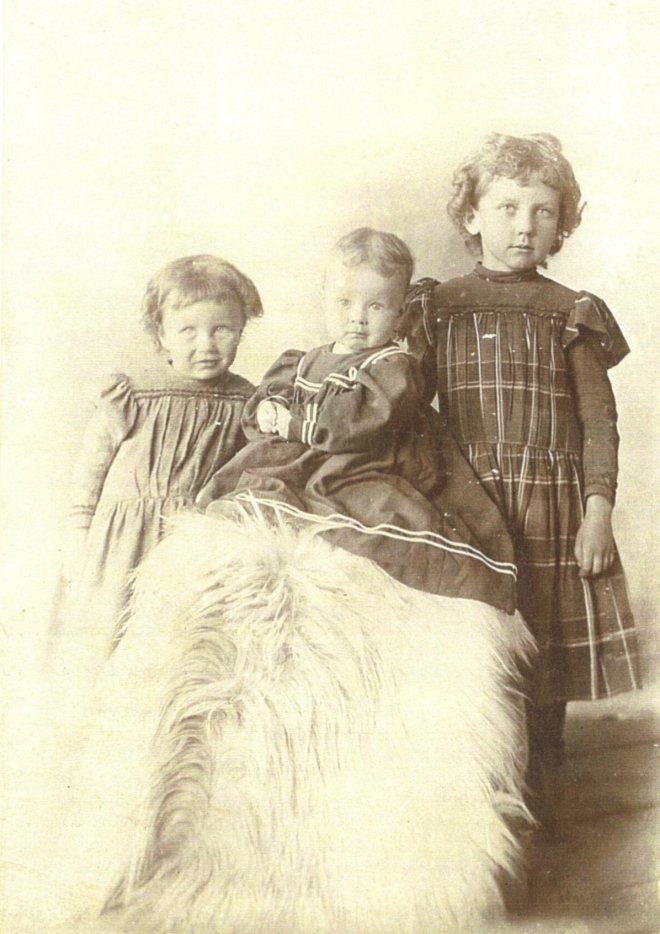
The three oldest surviving daughters of Franklin and Josephine Carlston in about 1900. Left to right: Florence Iona, Tressa Edith, and Josie Mae. Another sister, Ethel R., had died as an infant. Three more sisters, Affa Leora, Melba Louise, and Alta, and two brothers, Glenn Franklin and Jay R., were not yet born.
I have not yet been able to find any additional information about her last husband, Frank A. Jones, but while I was searching for more information about him, I discovered another marriage sandwiched between the other two. An item in the Salt Lake Telegram on July 31, 1940, page 19, showed a marriage license issued to Gilbert C. Beebe, 46, and Florence Ione Carlston Larsen, 41, both of Salt Lake; and the Utah Select Marriage Index documented a marriage between Florence Iona Carlston Larsen and Gilbert C. Beebe on July 30, 1940.
My search for Gilbert C. Beebe came up with newspaper articles about two different events: a Gilbert C. Beebe who was convicted of a brutal rape in 1926, and a Gilbert Clyde Beebe who was convicted of robbery in 1939. My next step was to determine whether these were the same person. Then, once it was decided that they were the same person, I needed to determine whether this was the Gilbert C. Beebe who was married to Florence Carlston.
Parole records following the 1939 conviction mentioned that Gilbert Clyde Beebe was the brother of the Piute County Sheriff Carl G. Beebe. That would indicate that Gilbert Clyde Beebe was the son of George Martin Beebe and Lilly Mae Crow. The Gilbert C. Beebe who was convicted in 1926 had a wife and three daughters. In the 1930 United States Federal Census, we can see Gilbert C. Beebe’s wife, who had been granted a divorce in 1928, living with her new husband and two of those daughters who had taken the new husband’s last name. The oldest daughter, however, can be seen living in the household of George and Lilly Beebe, listed as a granddaughter and using the last name Beebe. This would indicate that the Gilbert C. Beebe who was convicted in 1926 was the same person as the Gilbert Clyde Beebe who was convicted in 1939.
Before I made this connection, I was doubting that they were the same person, mostly because the article about the sentencing in the Deseret News on March 25, 1939, page 9, indicated that the judge in the 1939 robbery conviction “in view of Beebe’s past record … would be inclined to recommend leniency to the State Board of Pardons.” This would seem unlikely after Gilbert’s 1926 rape conviction. I have decided that either the judge was unaware of that record, or perhaps the newspaper reporters may have used the words “inclined to” when they really meant “inclined against.”
I could not find any documentation to prove that this Gilbert Clyde Beebe was the same Gilbert C. Beebe who married Florence Carlston in 1941, but circumstantial evidence seems to indicate that he might have been. I could not find evidence of any other Gilbert C. Beebe of the appropriate age and in the same area at the time. There is a discrepancy in Gilbert’s actual age (38) and the age given in the newspaper item about the marriage (46), but this could also be attributed to a misprint in the newspaper and would not absolutely rule out this being the same person.
The Wives and Crimes of Gilbert Clyde Beebe
Gilbert Clyde Beebe, the seventh of ten children born to George Martin Beebe and Lilly Mae Crow, was born December 30, 1901, in Circleville, Piute, Utah. The first five children in the family died quite young, so Gilbert was actually the second of the five children who survived past their twenties.
Ada Mansor
Although she was never married to Gilbert, Ada Mansor was the mother of Glbert Clyde Beebe’s first daughter, when Gilbert was just sixteen years old. Ada died on February 7, 1922, from complications following an operation for appendicitis a week prior. Their daughter was adopted into a local family whose last name she adopted for the rest of her life.
Elizabeth Goulding
Gilbert Clyde Beebe married Elizabeth Goulding on April 5, 1820. They had three daughters together, born in 1921, 1923, and 1926. Elizabeth was granted a divorce from Gilbert on January 18, 1928, in Salt Lake City. She remarried in December of that year and had two additional children with her new husband. She died on August 23, 1992, in Bountiful, Davis County, Utah.
1926 Rape Conviction
On October 9, 1926, Gilbert C. Beebe was sentenced in the Third Judicial District Court in Salt Lake County by Judge Chris Mathison. He had been convicted of the criminal assault of a 24-year-old girl. According to the case presented by the district attorney, E.A. Rogers, Gilbert and his co-defendant, Alvin Mecham, met two girls at a dance and took them for a drive in an automobile. There is no mention of what happened to the other girl, but the victim of the assault was said to have been attacked by both men. Mecham knelt on her arms and placed his hands over her mouth to keep her from resisting or crying out. The girl bit Mecham’s hand, at which point he beat her in the face, knocking her unconscious and causing severe injuries.

This headline from “The Sale Lake Tribune” on October 10, 1926, page 24, highlights the fact that the judge ignored the district attorney’s recommendation of life in prison.
Beebe’s defense seemed to be that Mecham had initiated the attack, that it was Mecham and not he who beat the girl and knelt on her arms, that the girl had not resisted his advances on the dance floor or later in the car and “was willing to go to the limit except to the point of extreme immorality,” and that the girl had taken a drink of liquor while in the car.
The judge sentenced Beebe to an indeterminate sentence in the State Prison, recommending to the Board of Pardons that he serve at least fifteen years. The district attorney made a separate recommendation to the Board of Pardons that he be kept in the State Prison for the rest of his life.
Gilbert was denied parole in 1927, 1928, and 1929. His parole was granted in August 1930. I have determined this date from an item in the Salt Lake Tribune, January 23, 1934, page 9, concerning the termination of his parole, stating that he was on parole at the time and had served three years, ten months.
Una Armanita Heaps
Gilbert Clyde Beebe married Una Armanita Heaps on March 30, 1931, in Tooele, Tooele County, Utah. They had two daughters together, born in 1932 and about 1937. They were divorced shortly after the birth of their second daughter, at which time she remarried. She divorced her second husband after less than three years, and was married two additional times before she died in March 1990.
1939 Robbery Conviction.
On March 25, 1939, Gilbert Clyde Beebe was sentenced in the Third Judicial District Court in Salt Lake County by Judge P.C. Evans. He had been convicted on a charge of robbery. Gilbert and his co-defendant, Martin Romero, were accused of taking W.E. Bettinson into an alley, slugging him, and robbing him of ten dollars.
Beebe maintained his innocence and claimed the prosecution was due to animosity over the fact that his brother, Piute County Deputy Sheriff Carl George Beebe, had arrested the alleged victim’s son several times.
The judge sentenced Beebe to an indeterminate sentence in the State Prison. An article about his sentencing in the Deseret News on March 25, 1939, said the judge “advised the pair that in view of Beebe’s past record, the court would be inclined to recommend leniency to the State Board of Pardons.” It is hard to imagine that the judge would not have seen Beebe’s previous conviction for rape, so I am assuming this was a misstatement by the newspaper.
Beebe was paroled effective July 21, 1941, after serving two years, three months. It was understood at his parole hearing that his brother, Piute County Sheriff Carl G. Beebe, would assist him in finding employment as a barber.
Florence Iona Carlston
I don’t have any absolute confirmation that Gilber Clyde Beebe was the same Clyde C. Beebe who married Florence Iona Carlston on July 30, 1940, in Salt Lake City, merely one week after his parole, but I believe the evidence makes it possible. Florence had been previously married to Raymond A. Larsen, which whom she had two sons and one daughter.
Florence and Gilbert seem to have divorced prior to 1942. Florence appears in the 1942 Salt Lake City Directory living under her maiden name at the same address as her parents. Gilbert’s World War II Draft Registration card gives his employer, Ray Peterson of Ray’s Barber Shop, as the person who would always know his address, and does not mention a wife.
Florence went on to marry Frank A. Jones, and she died on September 20, 1945, in Salt Lake City.
Helen Van Wagoner
Gilbert Clyde Beebe married Helen Van Wagoner on December 7, 1944, in Vancouver, Clark County, Washington. Helen had been previously married and divorced, and had one daughter.
An item in the Los Angeles Times on May 3, 1950, page 20, shows their divorce being granted there at that time.
Helen died on December 29, 1966, in Salt Lake City. Her obituary mentions her marriage to Gilbert without mentioning their divorce, and it lists his daughters as her step-daughters.
Another Elizabeth?
Finally, there was a newspaper item carried in both the Deseret News, May 10, 1946, page 25, and The Salt Lake Tribune, April 14, 1946, page 8B, showing a divorce granted to “Elizabeth Beebe from Gilbert C. Beebe, conviction of felony. Plaintiff awarded custody of minor children, $40 per month alimony and support money.” This is very confusing, because Gilbert Clyde Beebe was still married to Helen Van Wagoner at that time, but it makes me wonder whether there was another wife named Elizabeth and another felony conviction. Most likely, the newspapers were accidentally given a record of his 1928 divorce that got mixed in with the contemporary divorce records. I could find no records of another Gilbert C. Beebe of the right age in the area at that time, nor any records of a marriage between a Gilbert C. Beebe and an Elizabeth other than that to his first wife, Elizabeth Goulding.
The End of the Story
Gilbert C. Beebe seemed to spend the remainder of his days living sometimes in Utah, sometimes in California, and sometimes in Nevada. He died in December 1976 and is buried in Henderson, Clark County, Nevada. The Social Security Death Index shows his last known address as San Jose, Santa Clara County, California, and his last benefit having been sent to him in Las Vegas, Clark County, Nevada.
The saddest part of this story is the effect these kinds of events can have on the children involved. Although most of his children went on to live fairly normal lives, his oldest daughter from his first wife seems to have had some troubling times. She had gone to live with Gilbert’s parents after his rape conviction and subsequent divorce, and probably had more contact with Gilbert than the other daughters did. Perhaps she lacked a strong paternal figure to help her learn to make good choices in male partners. By the time she was twenty-two years old she had already been married four times, and she had a total of six husbands during her lifetime. Her fourth husband was convicted of polygamy, as he was already married to two other women at the time he married her.
It seems to me that someone who lives a life like Gilbert’s not only hurts his victims, but his actions also affect nearly everyone else in his life. It is not my judgment to make, but the district attorney in his original rape trial was probably right, and Gilbert probably should have stayed in prison for the remainder of his life. One has to wonder how he wound up on parole less than four years after committing such a horrific crime.

